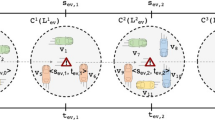Abstract
One of the most interesting recent topics in pervasive computing is the smart adaptive service support systems. These systems are impossible without knowing the context with the entity at the moment, what context was in the past and what is possible in the near future. The context alone is not so important in human oriented services provided in connected vehicles. In this environment we need to know not only the exact context but also the higher level information—situation. The situation awareness can be increased by exchanging it to other participating nodes—vehicles. Because the vehicular communication network is a very dynamic environment, it is essential to adequately respond to the user’s needs and to provide all the needed services in the right place at the right moment and in the right way. In this work we present our developed cooperative context data acquisition and dissemination model for situation identification in vehicular communication networks. Our solution is different from others as it uses additional virtual context information source—information from other vehicles is weighted and exchanged using the utility function. The proposed decision support system decides if the message should be transmitted to other vehicles, sent to the cloud, saved locally or dismissed. The simulation results show the promising context exchange rate between vehicles and huge saving on channel utilization.








Similar content being viewed by others
References
Fazio, P., De Rango, F., & Lupia, A. (2013). Vehicular networks and road safety: An application for emergency/danger situations management using the WAVE/802.11p standard. Advances in Electrical and Electronic Engineering, 11(5), 357–364.
Fazio, P., et al. (2013). Routing optimization in vehicular networks: A new approach based on multiobjective metrics and minimum spanning tree. International Journal of Distributed Sensor Networks, 2013, 1–13.
Cheng, H. T., Shan, H., & Zhuang, W. (2011). Infotainment and road safety service support in vehicular networking: From a communication perspective. Mechanical Systems and Signal Processing, 25(6), 2020–2038.
Ye, J., Dobson, S., & McKeever, S. (2012). Situation identification techniques in pervasive computing: A review. Pervasive and Mobile Computing, 8(1), 36–66.
Kakkasageri, M. S., & Manvi, S. S. (2014). Regression based critical information aggregation and dissemination in VANETs: A cognitive agent approach. Vehicular Communications, 1, 1–13.
Fazio, P., De Rango, F., & Sottile, C. (2012). An on demand interference aware routing protocol for VANETS. Journal of Networks, 7(11), 1728–1738.
Fazio, P., De Rango, F., & Sottile, C. (2011). A new interference aware on demand routing protocol for vehicular networks. In Proceedings of the international symposium on performance evaluation of computer and telecommunication systems (pp. 98–103).
Latré, S., Famaey, J., Strassner, J., & De Turck, F. (2013). Automated context dissemination for autonomic collaborative networks through semantic subscription filter generation. Journal of Network and Computer Applications, 36(6), 1405–1417.
Terroso-Sáenz, F., Valdés-Vela, M., Campuzano, F., Botia, J., & Skarmeta-Gómez, A. F. (2012). A complex event processing approach to perceive the vehicular context. Information Fusion, 21, 187–209.
Santamaria, A. F., Sottile, C., Lupia, A., & Raimondo, P. (2014). An efficient traffic management protocol based on IEEE802.11p standard. In Proceedings of the international symposium on performance evaluation of computer and telecommunication systems, SPECTS (pp. 634–641).
Bettini, C., Brdiczka, O., Henricksen, K., Indulska, J., Nicklas, D., Ranganathan, A., & Riboni, D. (2010). A survey of context modelling and reasoning techniques. Pervasive Mobile Computing, 6(2), 161–180.
Latré, S., Famaey, J., Strassner, J., & De Turck, F. (2013). Automated context dissemination for autonomic collaborative networks through semantic subscription filter generation. Journal of Network and Computer Applications, 36(6), 1405–1417.
Kakkasageri, M. S., & Manvi, S. S. (2014). Information management in vehicular ad hoc networks: A review. Journal of Network and Computer Applications, 39, 334–350.
Wang, S., & Huang, Y. (2012). NCTUns distributed network emulator. Internet Journal, 4(2), 61–94.
Acknowledgments
This work has been supported by the European Social Fund within the project “Development and application of innovative research methods and solutions for traffic structures, vehicles and their flows”, code VP1-3.1-ŠMM-08-K-01-020 and by the grant of SGS No. SP2014/72 conducted in VSB-Technical University of Ostrava.
Author information
Authors and Affiliations
Corresponding author
Rights and permissions
About this article
Cite this article
Kurmis, M., Andziulis, A., Dzemydiene, D. et al. Cooperative Context Data Acquisition and Dissemination for Situation Identification in Vehicular Communication Networks. Wireless Pers Commun 85, 49–62 (2015). https://doi.org/10.1007/s11277-015-2727-1
Published:
Issue Date:
DOI: https://doi.org/10.1007/s11277-015-2727-1




